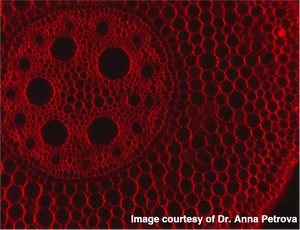
Investigation of plant growth and development is now more than ever an important field of study following the many challenges faced in agriculture. Accurate methods and computational models of plant cell- and organ change during growth are therefore essential to tackle problems like increased food demand in the wake of climate change. Researchers at Kazan Institute of Biochemistry and Biophysics aimed to determine if the mechanical properties of root tissues can control growth. Since growth rate and direction is determined by mechanical properties of plant cell walls, they used an approach based on atomic force microscopy (AFM) to study cell wall elasticity and turgor pressure in elongating primary root tissues of maize. They determined the elasticity of maize root cell walls in the four root development zones called meristem, early elongation-, active elongation-, and late elongation zone. Interestingly, they found that cell walls in root tissues show different patterns of elasticity along the length of the root. Some cell walls have increased stiffness only in the late elongation zone (AAAB type), others had increased stiffness in meristem and late elongation zones (BAAB type) and again others showed the same pattern, but the stiffness was even more increased in the late elongation zone than in the meristem (BAAC type). To understand if there is a link between the cell wall’s elasticity and its polysaccharide composition, the researchers coupled AFM analysis with fluorescent labelling of cell wall polysaccharides. Carbotrace 680 was used for detection and quantification of cellulose.
Image: Carbotrace 680 labelling cellulose in maize root. Image courtesy of Anna Petrova. Click here to read more about the author's experience with Carbotrace 680) along with fluorescent labelled antibodies.
The signal intensity of Carbotrace 680 and the polysaccharide-binding antibodies was plotted against the elasticity in the different developmental zones along the length of the root. In contradiction to previous studies, no correlation was observed. The presence of the polysaccharides studied could therefore not be used to predict the elastic moduli of cell walls. However, by normalizing the fluorescence intensity of the fluorescent antibodies binding to hemicelluloses to that of Carbotrace 680 binding to cellulose, they revealed that a reduction in the degree of homogalacturonan methylation was coupled with a transition from division to elongation and the overall decrease in the elastic modulus of cell walls between the meristem and early elongation zone of maize root. Further, the authors were able to show that cellulose and galactoxyloglucan contents in cell walls might be important for growth patterns in developing roots. Understanding how environmental factors can influence root growth and, eventually, the ability to predict and engineer certain growth properties might be an essential step to face current and future challenges. There is a high demand for increased biomass to feed the world's population considering the effects of global warming and following a global initiative to replace fossil fuels with renewable resources. At Ebba Biotech, we are extremely proud that Carbotrace contributes to research looking into carbohydrate content of plant cell walls on a subcellular level.
